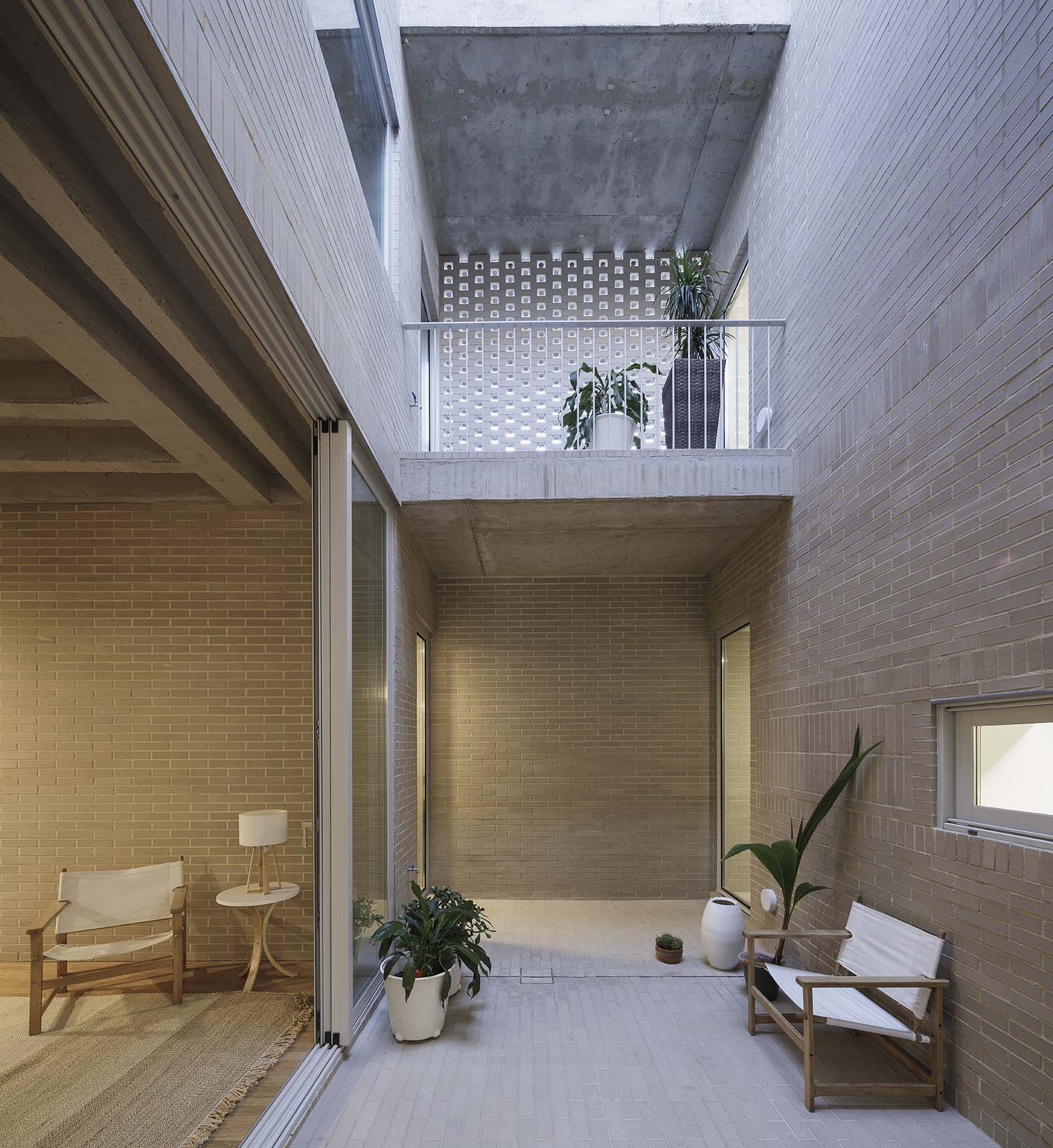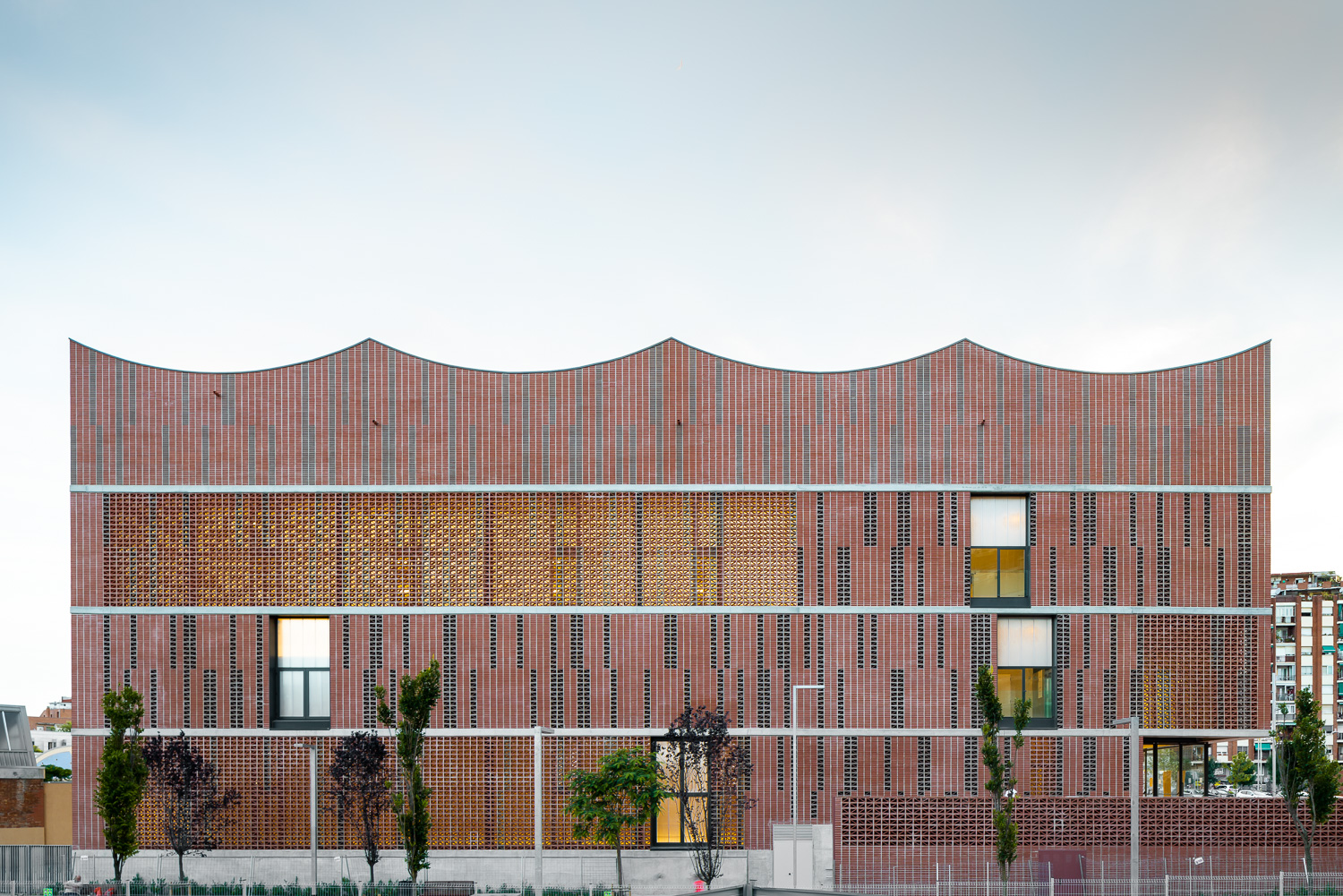An example of this versatility are these 3 collective housing, single-family housing and non-residential projects developed in our country.
Vertical Village (Madrid)
Project by Llps Arquitectos where Miguel Ángel Sánchez and Eduardo Pérez Gómez sought to develop a high-rise building to optimize the use of urban space by proposing a vertical framework that addresses a program of social and family diversity. The homes enjoy their own spaces but their composition facilitates neighborhood relations. In the project, the south-facing exposed brick façade with double skin, setbacks and latticework stands out for its beauty and efficiency.

10x10 by Sol89. Photograph by Fernando Alda.
10x10 House
María González García and Juanjo López de la Cruz of Sol89 Arquitectura, designed a double wall box of exposed brick, the exterior in English format and the interior in Spanish format. In this interior, the intention to incorporate the patio space into the living room suggests using the same material to confuse the limits between interior and exterior. The materiality of the grayish facing brick reduces the future maintenance of the house, also used in the exterior floors together with the ceramic slabs of the roof, and the inter-beaming of the concrete slabs, expands the perception of the rooms and gives the space a constructive expression that qualifies the abstraction of the plant.

Camp del Ferro Sports Center by AIA Activitats Arquitectòniques, Barceló-Balanzó Arquitectes, and Gustau Gili Galfetti. Photography by UTE Camp Del Ferro.
Camp del Ferro Sports Center
A LEED Gold certified project by the architects Albert Salazar Junyent and Joan Carles Navarro (partners of AIA), by Antoni Barceló and Bàrbara Balanzó (members of the Catalan studio Barceló-Balanzó arquitectes), and by the architect Gustau Gili Galfetti. In it, the façade is made of exposed brick, a material that ensures good aging and long life. At the same time, with the aim of lightening the whole on all the facades, empty and full parts, opaque, translucent or transparent parts, ceramic pieces of various formats and colors alternate. And furthermore, the use of this material comes from understanding the recovery of the memory of local traditions, with ceramic brick being very common on the facades of old factories, warehouses, workshops, or neighboring industrial warehouses.
"Face facades: complete ecosystem"
The Gremi de Rajolers of the Valencian Community developed the campaign “Face Facades: Complete Ecosystem” with the collaboration of the Generalitat Valenciana through the INENTI Project, whose objective is to show the benefits and advantages of facing ceramic brick facades compared to others. solutions.
For more information visit fachadascaravista.es
Vertical Village (Madrid)
Project by Llps Arquitectos where Miguel Ángel Sánchez and Eduardo Pérez Gómez sought to develop a high-rise building to optimize the use of urban space by proposing a vertical framework that addresses a program of social and family diversity. The homes enjoy their own spaces but their composition facilitates neighborhood relations. In the project, the south-facing exposed brick façade with double skin, setbacks and latticework stands out for its beauty and efficiency.

10x10 by Sol89. Photograph by Fernando Alda.
10x10 House
María González García and Juanjo López de la Cruz of Sol89 Arquitectura, designed a double wall box of exposed brick, the exterior in English format and the interior in Spanish format. In this interior, the intention to incorporate the patio space into the living room suggests using the same material to confuse the limits between interior and exterior. The materiality of the grayish facing brick reduces the future maintenance of the house, also used in the exterior floors together with the ceramic slabs of the roof, and the inter-beaming of the concrete slabs, expands the perception of the rooms and gives the space a constructive expression that qualifies the abstraction of the plant.

Camp del Ferro Sports Center by AIA Activitats Arquitectòniques, Barceló-Balanzó Arquitectes, and Gustau Gili Galfetti. Photography by UTE Camp Del Ferro.
Camp del Ferro Sports Center
A LEED Gold certified project by the architects Albert Salazar Junyent and Joan Carles Navarro (partners of AIA), by Antoni Barceló and Bàrbara Balanzó (members of the Catalan studio Barceló-Balanzó arquitectes), and by the architect Gustau Gili Galfetti. In it, the façade is made of exposed brick, a material that ensures good aging and long life. At the same time, with the aim of lightening the whole on all the facades, empty and full parts, opaque, translucent or transparent parts, ceramic pieces of various formats and colors alternate. And furthermore, the use of this material comes from understanding the recovery of the memory of local traditions, with ceramic brick being very common on the facades of old factories, warehouses, workshops, or neighboring industrial warehouses.
"Face facades: complete ecosystem"
The Gremi de Rajolers of the Valencian Community developed the campaign “Face Facades: Complete Ecosystem” with the collaboration of the Generalitat Valenciana through the INENTI Project, whose objective is to show the benefits and advantages of facing ceramic brick facades compared to others. solutions.
For more information visit fachadascaravista.es



























